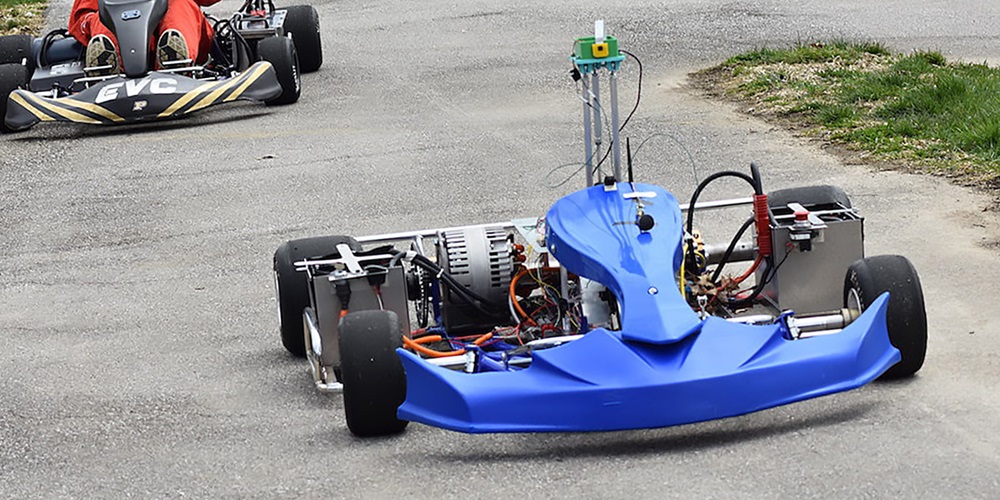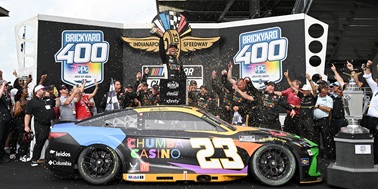During the Month of May, NTT IndyCar Series drivers are reaching top speed in the Indianapolis 500 presented by Gainbridge.
But for autonomous kart teams that will be taking to a special track in the infield of the Indianapolis Motor Speedway, drivers need not apply.
Purdue University Motorsports again will showcase its evGrand Prix for high school and college divisions on Tuesday, May 14 and Wednesday, May 15 at IMS. And for the second year, autonomous karts will take to the makeshift track inside the Speedway grounds for the Student Karting World Finals presented by Hoosier Racing Tire.
The races are included as part of the daily gate admission at Indianapolis Motor Speedway, which includes Indianapolis 500 presented by Gainbridge practice sessions.
The series has partnered with Top Kart USA for participating teams to purchase kart kits, which include chassis and battery technology. The series has also provided lidar sensors from Velodyne, which donated $5,000 worth of sensors to each autonomous team this year. Students are allowed to experiment with powertrains and software packages.
But how do the karts go?
In place of the seat where a driver would sit, there is a computer box and a pole with a camera and lidar sensors mounted on the top. Karts also come with a remote control to assist with functions such as starting and stopping.
The lidar sensor operates similarly to radar or sonar sensors, but it uses light instead of sound. Karts use this sensor to determine the distance between it and the objects around it, such as a wall, a person or another kart.
The computer vision sensor is separate and just as important as the lidar sensor. It is a camera that feeds the footage into a software platform on a small computer such as a Raspberry Pi (or "brain" of the kart). That software breaks down the footage into sequential images, which are analyzed for line detection and object recognition. This allows the kart to detect lane markings or the edge of a road, something the lidar sensor wouldn't be able to detect since these items are only visible and would not show up as an object. Together these two sensors make up the core of an autonomous system.
Battery technology is also improving. The lithium batteries on these karts have almost 5,000 watt-hours of energy and can supply more than 500 amps of current – that's about 20 kilowatts of power that can accelerate a kart almost as fast as a Tesla Model 3.
In racing conditions, these karts can go around the track for about 100 laps reaching speeds of 50 to 70 mph. However, most of the high-powered drivetrains are meant for the driver karts. Currently, autonomous karts range between 15 and 25 mph as the software and autonomous controls are always improving to allow for faster speeds.
Racing teams involve engineers with mechanical, electrical and technology backgrounds. Autonomous race teams will need to involve additional software engineers, especially those with autonomous, artificial intelligence and machine learning backgrounds.
Additional advantages to electric and autonomous kart racing include reduced carbon footprints and reduced noise pollution. Since there is no sound or fumes created from the kart, it is very easy to practice indoors or in public places that would normally ban the noise.
This is one of many events celebrating Purdue’s Sesquicentennial, 150 Years of Giant Leaps. This yearlong celebration is highlighting Purdue’s remarkable history of giant leaps, while focusing on what giant leaps Purdue can take to address the world’s problems. One of the four themes is “Artificial Intelligence, Algorithms and Automation: Balancing Humanity and Technology.”
Fast Facts about Purdue evGrand Prix
Tuesday, May 14: 20 lithium-powered karts from colleges across the country will compete in the college-series race, starting at 4 p.m.; collegiate autonomous kart practice – various times.
Wednesday, May 15: 24 high schools and technical career training centers will compete in manned karts at 4 p.m.
Wednesday, May 15: Collegiate autonomous kart race starting at 2 p.m.
Indiana high schools tentatively scheduled to participate are Ben Davis, Carroll, Castle, Clarksville, Clinton Central, Clinton Prairie, Decatur Central, Greenwood, Heritage Christian, Hobart, Fort Wayne Homestead, Indiana Math and Science Academy of Indianapolis, Jennings County, Lafayette Jefferson, Lowell, New Castle Career Center, North Lawrence Career Center, Paoli, Rensselaer Central, Rochester Community, and Speedway. Teams from other states are Plano (Texas), Hughes STEM of Cincinnati, and Maine 207 CTE of Park Ridge, Illinois.
Participating colleges are Purdue West Lafayette, Purdue Northwest, Anderson University, Kettering University, Kennesaw State University, Bowling Green University, Virginia Tech, Ivy Tech and Northwest Missouri State University.
College, High School Students Put Next-Gen Tech on Track in Purdue evGrand Prix May 14-15 at IMS

During the Month of May, NTT IndyCar Series drivers are reaching top speed in the Indianapolis 500 presented by Gainbridge. But for autonomous kart teams that will be taking to a special track in the infield of the Indianapolis Motor Speedway, drivers need not apply.
Latest News
View All News
Fox Corporation Acquires One-Third Interest in Penske Entertainment
Strategic investment, partnership includes a multiyear extension of INDYCAR's media rights with FOX Sports.

Public Days Updated for Indianapolis 8 Hour at IMS
Fans can enjoy two nights of action with headlights on at dusk Oct. 16-18 at the Racing Capital of the World.

Wallace Hangs On To Win Dramatic Brickyard 400 in Double Overtime
Bubba Wallace (photo) became the first African American to win the NASCAR Cup Series crown jewel race at IMS.
